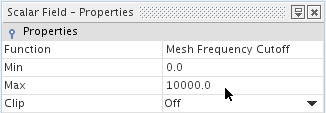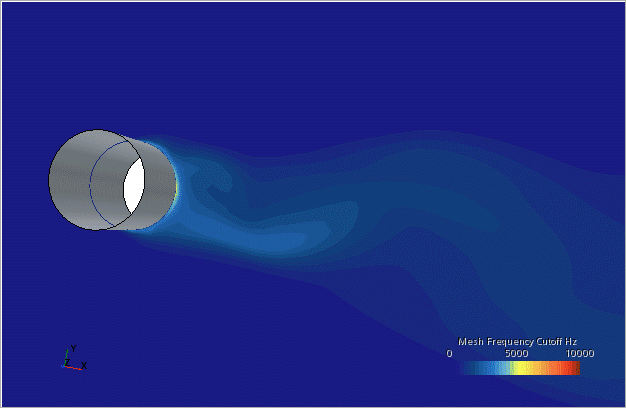Results Analysis
Compare the peaks in the spectra with the Mesh Frequency Cutoff plot from the final steady-state simulation.
- Open the simulation file for the steady-state calculation after 400 iterations (that is, the file cylinder.sim containing the refined mesh) alongside the existing cylinderUnsteady_FFT simulation.
- In the same Simulation window, open the node.
- Right-click and select
-
Select the node and set Max to
10000.


Compare the predicted spectra with the Mesh Frequency Cutoff plot from the steady-state simulation. You can see that there is a close correlation between the steady-state estimated cut-off frequency and the high-end frequency resolution from the DES calculation. All spectra show a change of gradient at ~6000 Hz. The change in gradient represents a change in the energy cascade to the higher frequencies, resulting artificially from inadequate resolution of the turbulent structures. These gradient kinks correspond with the fine-mesh steady-state Mesh Frequency Cutoff values local to those points. The spectral peak at ~500 Hz is the predicted vortex shedding frequency.
Many researchers (for example, Strouhal, Oertel, and Williamson, among others) have studied the sound that is generated by the flow around a circular cylinder.
Strouhal found that the frequency of the sound that is radiated from a cylinder of diameter is related to the free-stream velocity of a uniform flow. This relation is known as the Strouhal number . The Strouhal number is 0.2 to 0.22 for the Reynolds number range (Inoue). For this case of a cylinder 20 mm in diameter and a free-stream air velocity of 50 m/s, the Reynolds number is 6.38 × 104 and the Strouhal number is 0.2. The frequency of the sound is 500 Hz. This predicted frequency is identical to the shedding frequency of vortices behind the cylinder.
The SPL vs. frequency plot can numerically predict the frequency peak of 500 Hz generated by vortex shedding from the cylinder surface into its wake. This suggests that DES predicts the vortex shedding well and that the Strouhal number is close to the experimental value.
- Save and close the simulation.